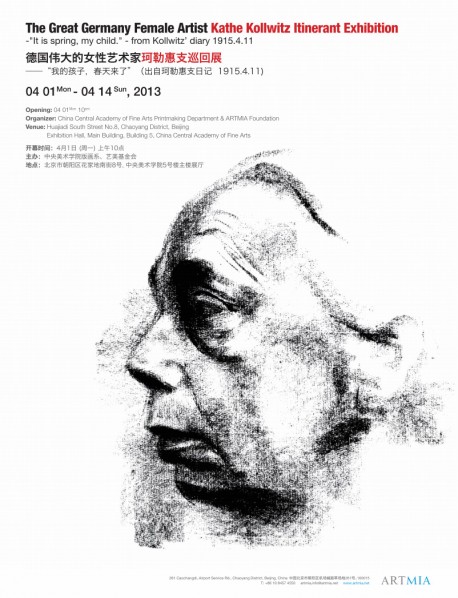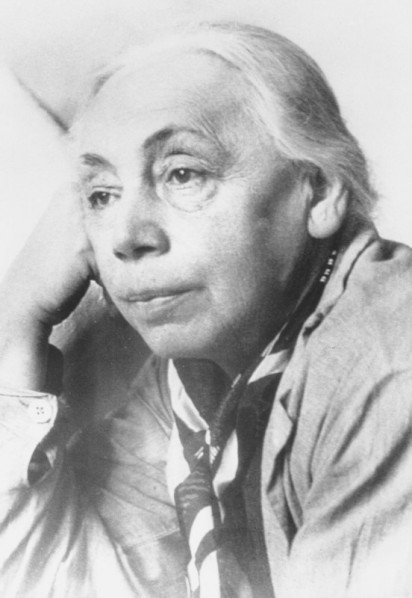
Half a year ago today, Karl saw you for the last time and half a year ago tomorrow, I saw you for the last time. You said: “I will come back.” I took the withered leaves from your bed and covered things belonging to you with a cloth. On the white sheet is some white birch. [...] By your bed ... It is spring, my child.
- from Kollwitz’ diary 1915.4.11
The title of this exhibition traces back to the personal diary of the german female graphic artist K?the Kollwitz. On April 11. 1915, she wrote a soundless exclamation of maternal sadness and sorrow for her youngest son. Peter died in 1914 during World War I. This unexpected tragedy had not only enormously affected her personal life, but also changed her art substantially, which is one of the main subjects of this exhibition.
In western art history, very few artists have devoted their artistic careers exclusively to printmaking. K?the Kollwitz, whose primary means of expression was printmaking, stands out as a powerful and compelling figure in the development of early 20th century German art. Her work visually integrates social, emotional, ethical and political issues, motivated by her experience of social injustice under the reign of Kaiser Wilhelm II and during World War I. In this era of political unrest, Kollwitz found printmaking the most acceptable medium for transmitting her message to a broad public venue. As a venerable populist medium, graphics were accessible to the impoverished working class, enabling Kollwitz to serve all sectors of society through her art. The implicit understanding between the artist and the populace encouraged her to shape her message through this most democratic of all art forms. Both her life and her pictorial language were devoted to an investigation of the human condition, to a penetration of the spiritual and physical plight of the underclass. In her prolific career she produced over 270 etchings, woodcuts and lithographs, which speak to our times maternal voice alike, as they did to her own.
This exhibition takes a new look at the graphic works of K?the Kollwitz in respect to her influence on the development of Chinese graphic art, as well as her traces in Chinese contemporary art, which have been strongly engraved onto the creative spirit of Chinese artists ever since her acceptance and widespread popularity in China in the early 1930‘s through the respected literate Lu Xun.

K?the Kollwitz
Dates of her Life and Work in the Context of contemporary Events1867
Born on July 8th as the fifth of seven children to Carl and Katarina Schmidt in K?nigsberg (After World War II Kaliningrad, Russia).
1871
The artist was 4 years old when the German Empire was founded. William I was proclaimed German Emperor.
1886-1890
Instruction in painting under Karl Stauffer-Bern at the Berlin Art School for Women and later on, under Ludwig Herterich at the Munich Art School for Women. Afterwards she acquired the fundamentals of etching in K?nigsberg.
1891
At the age of 24 K?the Schmidt married the physician Karl Kollwitz.
1891
Moving to Berlin to Wei?enburger Str. 25 in the Prenzlauer Berg District of Berlin (today Kollwitz Str. 56a).
1892-1896
Birth of the first son, Hans, in 1892. Birth of the second son, Peter, in 1896.
1893-1897
Inspired by one of the earlier performances of the drama The Weavers by Gerhart Hauptmann, the artist evolved her first graphic cycle A Weavers’ Revolt (completed in 1897).
1898-1899
For the first time at age 31 she attained widespread recognition with the cycle A Weavers’ Revolt at the Great Berlin Art Exhibition. The jury, composed of Max Liebermann, and others, proposed that the artist’s work receive the commendation ‘with distinction’. Emperor Williams II, however, rejected this proposal. K?the Kollwitz is appointed an instructor (until 1903) at the Berlin Art School for Women. She became a member of the Berlin Secession (a group of mostly young artists, who disputed the traditional ideals governing the academic and courtly conceptions of art).
1901-1908
Beginning of work on the cycle Peasants’ War (completed as a series of etchings in 1908). First stay in Paris.
Long stay in Paris. She acquired the techniques of fashioning sculpture at the Académie Julian. She visited Auguste Rodin.
1907
In 1907 she spent several months in Florence, having won the Villa-Romana Prize, awarded by the German Artists’ League. She undertook a journey by foot to Rome.
1908-1911
Sketches for the satirical magazine Simplicissimus. In 1910 she began sculptural studies leading to the realization of her own designs.
1914
Outbreak of the First World War. Her son, Peter, a volunteer, was killed at the West front in Belgium. First plans for a Memorial for the Dead.
1917-1918
On the occasion of her fiftieth birthday, exhibitions throughout Germany. (In Berlin her works were shown at Paul Cassirer’s).
She began her determined campaign to end the war with an Open Letter in the newspaper Vorw?rts. Abdication of William II on November 9. Philipp Scheidemann proclaimed Germany to be a Republic.
1919
The First German Republic was established with a constitution in Weimar. K?the Kollwitz, now 52, became the first woman member of the Prussian Academy of Arts. She was granted the title of professor without any instructional responsibilities.
1920
Inspired by Ernst Barlach’s wood cuts, she began her own efforts at wood-cut technique.
1920-1924
She fashioned numerous placards which were intended to influence the social and political events of the time. She worked on a series of wood-cuts entitled War, which was published in portfolio form. She also worked on her famous sculpture Mother with two Children which she finished in 1937.
1925
She met the American writer Agnes Smedly in Berlin – a socialist – who later on moved to Shanghai and became mediator between the artist and Lu Xun.
1927
Journey to Moscow at the invitation of the Soviet Government and Soviet Artists’ Alliance.
1928-1929
She was made Head of the Master’s Atelier for Graphic Art at the Academy of Art. She received the medal “Pour le mérite”.
1931
First contact with Lu Xun through Agnes Smedly, who worked for the well known poet, and the first publication of the artist in China was issued.
1932
The monument Mourning Parents was erected in Belgium. She gave her signature to an Appeal proposing the Union of all Leftist Parties against the approaching electoral victory of the National Social German Workers Party.
1933
Adolf Hitler became German Chancellor. Laws empowering a National Socialist dictatorship. The forced withdrawal of the sixty-six year old artist from the Academy of Art and dismissal from the post of Head of the Master’s Atelier.
1934-1939
The lithographic cycle Death took form in 1934-35. From 1937 on all exhibitions of K?the Kollwitz’s works were forbidden, and her works were no longer to be displayed in the exhibition rooms in museums. She devoted herself mostly to small sculptural models. 1939 the outbreak of World War II.
1940-1942
The death of her husband Karl Kollwitz in 1940. Her grandson Peter was drafted and later killed in Russia in 1942. In 1941 her last lithography Seed for sowing should not be milled -after Goethe.
1943
Because of the air-raids she left Berlin after 52 years of work and residence in the city. She found lodgings in Nordhausen. Her Berlin apartment, along with many of her works and documents, was utterly destroyed by an aerial bombardment.
1944
At the invitation of Prince Ernst Heinrich of Saxony she settled in Moritzburg near Dresden.
1945
Shortly before the end of the war she died at 77. She was buried at first in Moritzburg and later in the Central Cemetery Friedrichsfelde in Berlin-Lichtenberg.
About the exhibition
Time: 2013.4.1(Mon.) - 4.14(Sun.)
Organizer: China Central Academy of Fine Arts Printmaking Department
ARTMIA Foundation
Venue: Exhibition Hall, Main Building, Building 5, China Central Academy of Fine Arts
Huajiadi South Street No.8, Chaoyang District, Beijing
Courtesy of China Central Academy of Fine Arts Printmaking Department and ARTMIA Foundation.




























